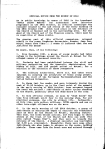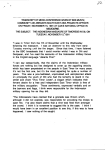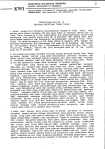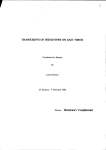In late 1978, a time of greatly intensified Indonesian military operations, senior resistance leader Alarico Fernandes transmitted a series of secret coded messages from Timor under the codename ‘Saturno’. The messages were later revealed to propose various actions against the Nicolau Lobato-led Fretilin Central Committee. Unsurprisingly, the proposals were condemned by the external delegation of Fretilin and Fernandes was branded a traitor.
The essence of the Saturno proposals was released by Fretilin’s external delegation in 1978, but the actual message texts were not published. As a contribution to ongoing research and scholarship on the Saturno/’Skylight’ issue, we introduce a surviving English-language version of the message texts.
The events and circumstances surrounding the defection of Alarico Fernandes to the Indonesian military in late 1978 remain a contested part of Timor-Leste’s resistance history. Further information can be found in our earlier article exploring unresolved questions about those events. Forthcoming research by others will offer new information and analysis. (1)
It is now possible for the first time to read an English-language version of the original Saturno messages. For ease of reading, CHART has also created a plain-text version of the document.
We do not intend here any detailed analysis of the messages but offer some introductory comments about the source document containing the messages.
What is the Saturno messages document?
The undated document is four pages of English-language typescript titled Translation of Saturno messages (decoded). It contains several numbered messages dated from 28 September to 22 November 1978. The document includes some explanatory notes from the creator of the document and is signed-off by ‘DF’.
Who created the document?
The document resides in the archives of the late Denis Freney (2), a very prominent Australian Timor activist in the 1970s and a key link in radio communications between the Timorese resistance and the Fretilin external delegation overseas. We can safely conclude that the ‘DF’ signature on the document refers to Denis Freney.
Is the document a full and accurate record of the original coded messages?
Neither the accuracy nor degree of completeness of this document can be stated until it has been compared with the original source materials. The absence of a numbered message (message ’03/78′) is one indication that the record may be incomplete.
The most original source is the sound recordings made in Darwin of the Saturno radio messages. These were reportedly transcribed in Australia at the time and then sent to Maputo for decoding – probably into Portuguese language in the first instance. (3) Audio tapes of some Saturno radio message survive in Australia and, if they can be decoded, should be compared with the present English-language document.
Until that comparison occurs, we are unable to confirm the accuracy of this ‘Freney version’ of the messages. At the request of Fretilin’s external delegation in late 1978, the message texts were held secret by Denis Freney. This fact strongly suggests the archival document is a reliable reflection of the content of the original Saturno messages. (4)
CHART Comment
The Saturno message texts are a key element required for detailed analysis of the Alarico Fernandes / Operation Skylight controversy. As more information about this pivotal moment in Timor’s resistance history comes to light, the better we are able to build a picture of the events and the circumstances that gave rise to it. The Saturno texts are published here to partly fill one gap in our present knowledge.
Notes / References
Also available, a Tetun translation of the ‘Saturno’ messages document and this article. Translation work by Uka Pinto.
(1) See ‘An American military officer has been killed’: The Radio Maubere link to the world and how it ended, by Peter Job in proceedings of the 2023 Timor-Leste Studies Association conference (forthcoming, 2024). Job draws on his direct experience in the late-1978 resistance radio operation in Darwin to conclude that Alarico Fernandes was under Indonesian control when the Saturno messages were sent. CHART is also aware of current research on the topic by the Timor-Leste history research group, Comite Orientador 25.
(2) Papers of Denis Freney, 1961-1995, National Library of Australia, MS 9535, Series 3, File 6.
(3) See Denis Freney’s autobiographical A map of days: life on the Left (1991), p.370.
(4) This question is explored in more detail in John Waddingham’s Authenticity, accuracy, bias: Interrogating primary source documents in proceedings of the 2023 Timor-Leste Studies Association conference (forthcoming, 2024).




 Posted by timorarchives
Posted by timorarchives 















